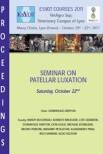Objectives: The aim of this study was to evaluate the post-sterilization dimensional accuracy of a standardized drilling guide, three-dimensionally printed using biocompatible methacrylate monomers.
Study design: A mock surgical guide was designed and printed in five resins (n = 5/material) using a commercially available desktop stereolithography printer. Pre- and post-sterilization dimensions were measured for each sterilization method (steam, ethylene oxide, hydrogen peroxide gas), then statistically compared; p-value less than or equal 0.05 was considered significant.
Results: While all resins produced highly accurate replicas of the designed guide, the amber and black resins were unaffected by any sterilization method (p ≥ 0.9). For other materials, ethylene oxide produced the largest dimensional changes. However, mean post-sterilization dimensional changes for all materials and sterilization methods remained less than or equal to 0.05mm CONCLUSION: This study demonstrated that post-sterilization dimensional change of evaluated biomaterials was minimal, and less than previously reported. Additionally, amber and black resins may be preferred to reduce post-sterilization dimensional change, as they were unaffected by any sterilization method. Given the results of this study, surgeons should feel confident using the Form 3B printer to create patient surgical guides. Furthermore, bioresins may provide safer alternatives for patients compared with other three-dimensional printed materials.









